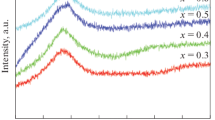Abstract
The interaction of the ribbon surface with acetone and its effect on the magnetic characteristics of ribbon are studied in this work using the example of soft magnetic Co-based AMAG-172 (Co–Ni–Fe–Cr–Mn–Si–B) amorphous alloy. The studies show the different effect of acetone treatment of ribbon on the magnetization distribution and magnetic permeability of material in states differing in the sign of saturation magnetostriction. The treatment of the ribbon in the state with λs > 0 favors the increase in both the volume of domains with the orthogonal magnetization and the magnetic texture sharpness in the ribbon plane; in the state with λs < 0, the treatment favors the decrease in both the volume of domains with the orthogonal magnetization and magnetic texture sharpness and an increase in the maximum magnetic permeability. This can result from the predominantly planar anisotropic compressive stresses induced in the ribbon by catalytic oxidation and hydrogenation of acetone.




Similar content being viewed by others
REFERENCES
N. A. Skulkina, O. A. Ivanov, and I. O. Pavlova, “Interaction of the surface of ribbons of amorphous soft-magnetic iron-based alloys with water and their magnetic properties,” Phys. Met. Metallogr. 112, 457–465 (2011).
N. A. Skulkina, O. A. Ivanov, E. A. Stepanova, O. V. Blinova, P. A. Kuznetsov, and A. K. Mazeeva, “Effect of heat treatment in air and a chemically active environment on the magnetic properties of cobalt-based soft magnetic amorphous alloys,” Phys. Met. Metallogr. 117, 982–989 (2016).
N. A. Skulkina, O. A. Ivanov, O. V. Blinova, E. A. Mikhalitsyna, N. D. Denisov, V. I. Chekis, A. K. Mazeeva, and P. A. Kuznetsov, “Influence of a polymer coating and the compacting pressure on the magnetic properties of cobalt-based amorphous alloys,” Phys. Met. Metallogr. 118, 1176–1183 (2017).
I. B. Kekalo and B. A. Samarin, Physical Metal Science of Precision Alloys. Alloys with Special Magnetic Properties (Metallurgiya, Moscow, 1989) [in Russian].
N. A. Skulkina, O. A. Ivanov, I. O. Pavlova, and O. A. Minina, “Interaction of surface of ribbons of amorphous soft-magnetic iron-based alloys with vapor,” Phys. Met. Metallogr. 115, 529–537 (2014).
N. A. Skulkina, O. A. Ivanov, I. O. Pavlova, and O. A. Minina, “Interaction of the surface of ribbons of amorphous soft-magnetic alloys with vapor during isothermal holding upon heat treatment,” Phys. Met. Metallogr. 116, 1087–1095 (2015).
N. A. Skulkina, O. A. Ivanov, I. O. Pavlova, and O. A. Minina, “Interaction of the surfaces of ribbons of amorphous magnetically soft alloys with vapor at various stages of heat treatment,” Phys. Met. Metallogr. 116, 979–986 (2015).
N. A. Skulkina, O. A. Ivanov, L. N. Shubina, P. A. Kuznetsov, and A. K. Mazeeva, “Mechanisms of the magnetic properties improvement of amorphous soft magnetic Fe- and Co-based alloys as a result of heat treatment on air,” Phys. Procedia 82, 69–77 (2016).
I. P. Suzdalev, Nanotechnology: Physicochemistry of Nanoclusters, Nanostructures, and Nanomaterials (KomKniga, Moscow, 2006) [in Russian].
O. V. Shutkina, “Hydroalkylation of benzene with acetone on bifunctional catalysts,” Doctoral Dissertation in Chemistry (Lomonosov Moscow State University, Moscow, 2014).
N. A. Skulkina, “Magnetization distribution and magnetic properties of crystalline, amorphous and nanocrystalline magnetically soft materials,” Doctoral Dissertation in Mathematics and Physics (Ural State University, Ekaterinburg, 2007).
N. A. Skulkina, O. A. Ivanov, A. K. Mazeeva, P. A. Kuznetsov, V. I. Chekis, and N. D. Denisov, “Conditions for the formation of a polymeric coating and the magnetic properties of cobalt-based amorphous alloys,” Phys. Met. Metallogr. 119, 1154–1161 (2018).
N. A. Skulkina, O. A. Ivanov, A. K. Mazeeva, P. A. Kuznetsov, V. I. Chekis, and N. D. Denisov, “Temperature of the formation of a protective polymer coating and the magnetic properties of cobalt-based amorphous alloys,” Phys. Met. Metallogr. 120, 563–569 (2019).
https://amet.ru.
Funding
The study was partially supported by the Ministry of Science and Higher Education of the Russian Federation (project no. FEUZ-2020-0051).
Author information
Authors and Affiliations
Corresponding author
Additional information
Translated by N. Kolchugina
Rights and permissions
About this article
Cite this article
Skulkina, N.A., Denisov, N.D., Boyarchenkov, A.S. et al. Effect of Chemically Active Medium on Magnetic Characteristics of Soft Magnetic Co-Based Amorphous Alloy. Phys. Metals Metallogr. 121, 520–525 (2020). https://doi.org/10.1134/S0031918X20060150
Received:
Revised:
Accepted:
Published:
Issue Date:
DOI: https://doi.org/10.1134/S0031918X20060150




